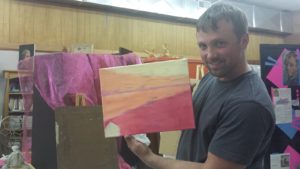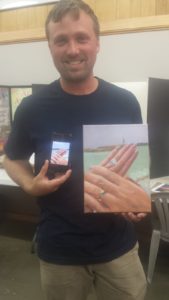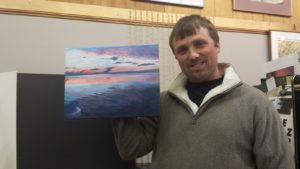ART STUDENT Boomerang Effect: Good Technique
19 - 12
2016
When Students Return
Nothing is more gratifying to a teaching artist than a student who asks for more. Sometimes, like Stuart Peregoy, 10-15 years later. Because nothing gratifies a teacher more than getting a second chance to pour expertise into a willing vessel. It’s called leaving a legacy.
So when Stuart Peregoy walked into my studio, I thought it was just to say hello and bring me up on events of his life since school days in the last 16 years or so, like about his getting married to the love of his life and building his first dream home together.

Stuart Peregoy paints warm underpainting in adult art class
And that would have been enough. I love my students and have enjoyed more visits than I can count from students who want to drop in and touch bases with me. I laughingly call myself ‘art mama,’ and 35 years of teaching certainly allows for growing new life adventures. But when they come back to drain your art knowledge bank, you are especially appreciative.
Sure, the first time round is great, full of enthusiasm and fun, discovery and direction in drawing in colored pencils, graphite, and pastels; painting in watercolor, oil, and acrylic. I once had a friend tell me she didn’t need lessons, she had taken art in high school. Ha-ha, as if everything in art could be learned in a few easy lessons. “Everything I know in art I learned in kindergarten” sort of concept. That underscores how undisciplined and uninformed our concept is of what’s to be learned in art. 
The second time around, a student takes it seriously, first of all. A return student is ‘broken in,’ has a great foundation laid already. They are willing to listen to detailed additions to their knowledge base. They’ve had the appetizer course, and now they are ready for the whole enchilada.
That’s why Stuart jumped right in and decided to go the master student route, pursue the best Old Masters’ techniques of painting. That’s why he knew to value the build-up knowledge being taught by master painters in ateliers that have popped up all across the country to combat the silly originality is everything notion, the low technique trend in art. Originality is not necessarily a good thing; it has to be a good, trained, originality. I cringe say this, looking for someone to slap me for breaking what’s being taught as the First Commandment of Art.
Stuart draws the picture he intends to paint first, skillfully, with full drawing school corrections. This he turns into a grisaille which provides a more sculptural, three-dimensional version of the drawing in black and white. Over this he paints a thin glaze of verdaccio or a neutral green called an imprimatura which gets rid of all the white. Then, and only then, does he begin to paint.
Why paint what you won’t see? you might ask.
The answer is, it determines the outcome.
Is learning to paint harder the second time around? I ask Stuart.
“It’s a lot harder than I thought it would be,” he said.
“Yes, and it’s a lot harder to teach techniques like modeling that grow with you your whole adult painting experience,” Joanna admits. “We are so intuitively good at coming up with variants of our techniques and just whisking and brushing away, that we avoid the discipline of the right approach. Many roads to Rome doesn’t apply as well to the accumulation of specific skills, so you have to have a tough skin to learn, and an endless ability to re-frame the verbal explanation for what to do, for troubleshooting just why it didn’t come out quite the way you wanted it to.”

Using the technique’s stated, he has captured the North Carolina Sea-Scape in this oil painting.
Mrs. Joanna, as her students affectionately call her, teaches all major categories of painting and drawing in her studio, Art on Broad Atelier/j’Originals’ Art Studio and has for over 30 years. She received art training from Art Instruction correspondence art school, from Queens University in Charlotte, from UNC-Chapel Hill, and additional courses from Methodist University, plus the odd courses from traveling New York Students’ Art League teachers and invited jurors in state watercolor exhibits. She is a signature member of two watercolor societies.
But back to Stuart. Stuart has just finished his second painting, a surprise birthday present to his wife, a 12″ x 16″ oil on canvas of his hand holding hers, the sea and beach in the background, rings on their fingers. His first painting was of his dog, Charlie.

Leave A Reply
You must be logged in to post a comment.